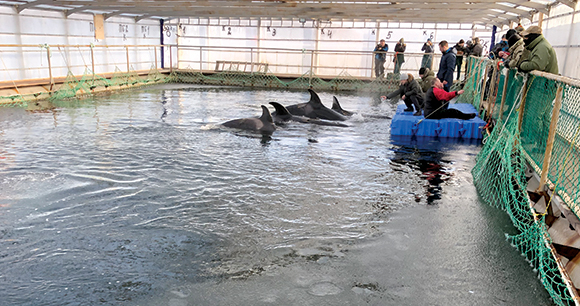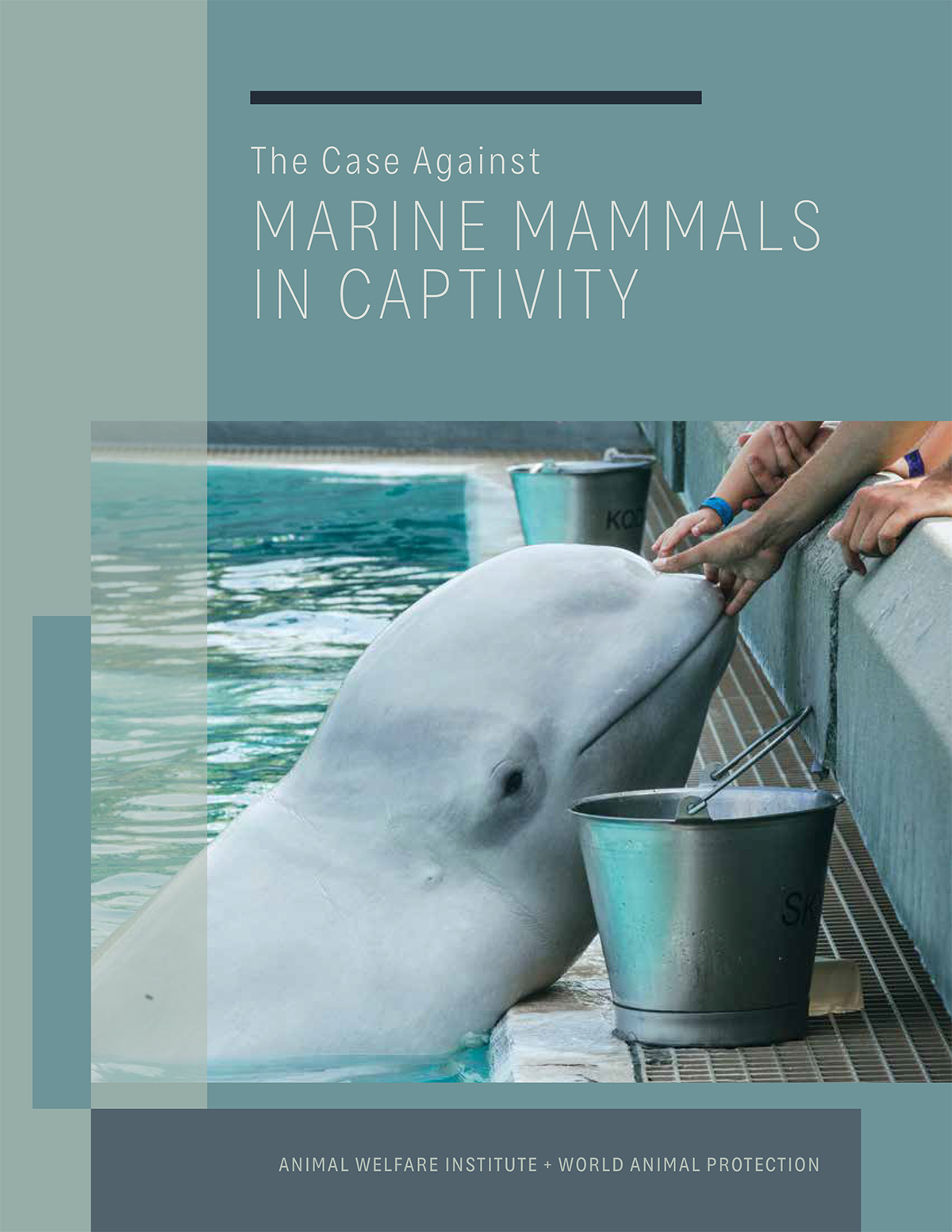
Washington, DC—The tide is turning in the West for captive marine mammals, yet live capture operations, traveling dolphin shows, polluted sea pens and needless deaths of animals continue to mar the captivity industry around the globe, especially in Asia, according to a report co-produced by the Animal Welfare Institute (AWI) and World Animal Protection (WAP).
 The fifth edition of “The Case Against Marine Mammals in Captivity,” released today at the ITB conference in Berlin, is meant to be a one-stop-shop for those who wish to learn why it is unacceptable to confine marine mammals for public display and entertainment. Citing robust scientific evidence and ethical arguments, the 156-page report delves into the behind-the-scenes realities of zoos, aquariums and marine theme parks that display these animals, which—despite the facilities’ assurances—do not provide essential or even accurate conservation or education resources. What’s more, marine mammals, with their aquatic ecology, suffer physical and mental health problems as a result of being confined in small enclosures. The lack of rigorous or extensive scientific assessment of captive marine mammal welfare at these operations is an issue of global concern.
The fifth edition of “The Case Against Marine Mammals in Captivity,” released today at the ITB conference in Berlin, is meant to be a one-stop-shop for those who wish to learn why it is unacceptable to confine marine mammals for public display and entertainment. Citing robust scientific evidence and ethical arguments, the 156-page report delves into the behind-the-scenes realities of zoos, aquariums and marine theme parks that display these animals, which—despite the facilities’ assurances—do not provide essential or even accurate conservation or education resources. What’s more, marine mammals, with their aquatic ecology, suffer physical and mental health problems as a result of being confined in small enclosures. The lack of rigorous or extensive scientific assessment of captive marine mammal welfare at these operations is an issue of global concern.
“Marine mammals simply cannot thrive in captivity,” said Dr. Naomi Rose, the report’s lead author and AWI’s marine mammal scientist. “Almost all marine mammal species are wide-ranging predators and the best we can provide for them are barren concrete boxes or small sea pen corrals.”
The 5th edition of this report—first produced in 1995—is especially timely in light of the recent announcement by Dolphinaris Arizona that it would close its dolphin exhibit after four dolphins died there in less than 18 months. Since the publication of the last edition in 2009, the controversy over captive marine mammals has intensified, largely due to high-profile documentaries such as “The Cove” and “Blackfish,” ensuring that every new proposal to build a dolphinarium anywhere in the world will receive increased scrutiny and skepticism.
“A lifetime in captivity for marine mammals such as dolphins is so contrary to their natural environment—it is simply no life at all,” said Nick Stewart, global head of the campaign on captive wildlife tourism at World Animal Protection. “Tourists and the global travel industry provide demand for existing and new captive marine mammal facilities, which is why we have chosen to launch the report at one of the world’s biggest travel shows. The arguments and evidence of suffering are here in plain language for travel companies to see.”
Other highlights from the report:
- While a paradigm shift is well underway in the West, with many countries prohibiting the display or breeding of cetaceans for entertainment or banning and restricting the trade in live cetaceans, live capture of free-ranging marine mammals, particularly cetaceans, continues. The capture hotspots in 2019 are Russia (belugas and orcas) and Japan (multiple dolphin species). The principal market today is China, where the number of ocean theme parks has jumped from 39 in 2015 to 76 in early 2019.
- Dolphin sea pen enclosures in Asia and the Caribbean are considered to be at extreme risk from hurricanes and tsunamis. Their construction also degrades coastal habitat, destroying mangroves and damaging coral reefs. Several facilities were severely damaged during the 2017 hurricane season in the Caribbean.
- The main concern for marine mammals in captivity is the artificial and barren nature of the environment, particularly the amount of space provided. In the wild, cetaceans can travel 40–100 miles a day, achieve speeds of 30 miles per hour, and dive hundreds of feet deep. Even in the largest facilities, cetacean are provided less than one-ten thousandth of 1 percent of their natural habitat range. One 2014 study found that a captive male orca spent nearly 70 percent of his time virtually motionless. Yet, global standards for captive enclosure size have not been revised or improved.
- The inadequate conditions provided to captive marine mammals give rise to a plethora of adverse impacts on their welfare. Most marine mammals are wide-ranging predators—confinement in small tanks or pens leads to stress, which, in turn, leads to a number of health problems, neurotic behaviors and abnormal levels of aggression.
- Bottlenose dolphins face a six-fold increase in mortality risk immediately after capture from the wild and transfer between facilities. Annual mortality rates for orcas have improved over the years, but they still don’t match healthy populations in the wild.
- Concern about swimmer safety and dolphin welfare has led several tourism companies, including TripAdvisor and Virgin Holidays, to end or restrict their promotion of swim-with-dolphin attractions.
Margie Fishman, (202) 446-2128, [email protected]
The Animal Welfare Institute (www.awionline.org) is a nonprofit charitable organization founded in 1951 and dedicated to reducing animal suffering caused by people. AWI engages policymakers, scientists, industry, and the public to achieve better treatment of animals everywhere – in the laboratory, on the farm, in commerce, at home, and in the wild. Follow us on Facebook, Twitter and Instagram for updates and other important animal protection news.
World Animal Protection (formerly known as the World Society for the Protection of Animals) has moved the world to protect animals for the last 50 years. World Animal Protection works to give animals a better life. Its activities include working with companies to ensure high standards of welfare for the animals in their care, working with governments and other stakeholders to prevent wild animals being cruelly traded, trapped or killed, and saving the lives of animals and the livelihoods of the people who depend on them in disaster situations. World Animal Protection influences decision makers to put animals on the global agenda, and it inspires people to protect animals and to change animals’ lives for the better. More information on World Animal Protection can be found at: www.worldanimalprotection.org